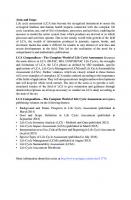THE SOFTWARE DEVELOPMENT LIFE CYCLE A COMPLETE GUIDE
Discover the essential handbook that demystifies the world of software development! Whether you're a seasoned profe
284 93 227KB
English Pages 359 Year 2023
Table of contents :
Table of Contents
Chapter 1: Introduction to the Software Development Life Cycle (SDLC)
Overview of SDLC13
Importance of SDLC in software development15
Evolution of SDLC methodologies29
Chapter 2: Waterfall Model
Explanation of the Waterfall Model24
Phases of the Waterfall Model (Requirements, Design, Implementation, Testing, Deployment, Maintenance)27
Advantages and disadvantages of the Waterfall Model32
Chapter 3: Agile Methodology
Introduction to Agile and its principles36
Scrum, Kanban, and Lean methodologies within Agile40
Iterative and incremental development in Agile45
Chapter 4: Scrum Framework
Overview of the Scrum framework50
Roles and responsibilities in Scrum (Product Owner, Scrum Master, Development Team)53
Scrum events (Sprint Planning, Daily Standup, Sprint Review, Sprint Retrospective)56
Chapter 5: Kanban Methodology
Understanding Kanban principles62
Visualizing workflows using Kanban boards66
Limiting work in progress and optimizing flow69
Chapter 6: Lean Software Development
Introduction to Lean Software Development74
Waste reduction and continuous improvement in Lean76
Value stream mapping and value delivery80
Chapter 7: DevOps Practices
Introduction to DevOps and its objectives86
Continuous Integration and Continuous Deployment (CI/CD)88
Infrastructure as Code (IaC) and configuration management92
Chapter 8: Requirements Gathering and Analysis
Importance of requirements gathering97
Techniques for gathering and documenting requirements101
Analyzing and prioritizing requirements106
Chapter 9: System Design and Architecture
Design principles and patterns111
Architectural styles (Layered, Client-Server, Microservices)116
Modeling and documenting system architecture121
Chapter 10: Coding and Implementation
Best practices for coding and writing clean code127
Version control and code review processes134
Unit testing and test-driven development (TDD)138
Chapter 11: Software Testing
Importance of testing in the SDLC144
Types of software testing (Unit, Integration, System, Acceptance)148
Test planning, execution, and reporting151
Chapter 12: Deployment and Release Management
Preparing software for deployment155
Release management strategies and practices159
Rollbacks and hotfixes in deployment163
Chapter 13: Maintenance and Support
Activities involved in software maintenance168
Bug tracking and issue resolution172
Enhancements and feature requests177
Chapter 14: Project Management in SDLC
Project planning and estimation183
Tracking progress and managing risks190
Stakeholder communication and project governance196
Chapter 15: Quality Assurance and Quality Control
Importance of quality assurance and quality control201
Defining quality standards and metrics205
Conducting audits and reviews210
Chapter 16: Documentation in SDLC
Types of documentation in software development218
Writing effective user manuals and technical documentation223
Documenting design decisions and system changes236
Chapter 17: Security in SDLC
Importance of security in software development232
Secure coding practices and common vulnerabilities236
Security testing and threat modeling242
Chapter 18: Performance Optimization
Identifying and profiling performance bottlenecks249
Techniques for optimizing code and system performance253
Load testing and performance monitoring257
Chapter 19: Agile Estimation and Planning
Estimation techniques in Agile projects (Story Points, Planning Poker)264
Agile release planning and backlog grooming269
Velocity tracking and sprint planning274
Chapter 20: Collaboration and Communication Tools
Tools for agile project management (Jira, Trello, Asana)280
Communication and collaboration platforms (Slack, Microsoft Teams)287
Version control systems and code repositories (Git, SVN)293
Chapter 21: Continuous Integration and Deployment Tools
Introduction to CI/CD tools (Jenkins, Travis CI, CircleCI)299
Building and automating software delivery pipelines301
Infrastructure provisioning and deployment automation306
Chapter 22: Agile Metrics and Reporting
Tracking progress with Agile metrics (Burndown charts, Velocity)314
Agile reporting and team performance analysis317
Retrospectives and continuous improvement322
Chapter 23: Agile Transformation and Scaling
Waste reduction and continuous improvement in Lean76
Value stream mapping and value delivery80
Chapter 7: DevOps Practices
Introduction to DevOps and its objectives86
Continuous Integration and Continuous Deployment (CI/CD)88
Infrastructure as Code (IaC) and configuration management92
Chapter 8: Requirements Gathering and Analysis
Importance of requirements gathering97
Techniques for gathering and documenting requirements101
Analyzing and prioritizing requirements106
Chapter 9: System Design and Architecture
Design principles and patterns111
Architectural styles (Layered, Client-Server, Microservices)116
Modeling and documenting system architecture121
Chapter 10: Coding and Implementation
Best practices for coding and writing clean code127
Version control and code review processes134
Unit testing and test-driven development (TDD)138
Chapter 11: Software Testing
Importance of testing in the SDLC144
Types of software testing (Unit, Integration, System, Acceptance)148
Test planning, execution, and reporting151
Chapter 12: Deployment and Release Management
Preparing software for deployment155
Release management strategies and practices159
Rollbacks and hotfixes in deployment163
Chapter 13: Maintenance and Support
Activities involved in software maintenance168
Bug tracking and issue resolution172
Enhancements and feature requests177
Chapter 14: Project Management in SDLC
Project planning and estimation183
Tracking progress and managing risks190
Stakeholder communication and project governance196
Chapter 15: Quality Assurance and Quality Control
Importance of quality assurance and quality control201
Defining quality standards and metrics205
Conducting audits and reviews210
Chapter 16: Documentation in SDLC
Types of documentation in software development218
Writing effective user manuals and technical documentation223
Documenting design decisions and system changes236
Chapter 17: Security in SDLC
Importance of security in software development232
Secure coding practices and common vulnerabilities236
Security testing and threat modeling242
Chapter 18: Performance Optimization
Identifying and profiling performance bottlenecks249
Techniques for optimizing code and system performance253
Load testing and performance monitoring257
Chapter 19: Agile Estimation and Planning
Estimation techniques in Agile projects (Story Points, Planning Poker)264
Agile release planning and backlog grooming269
Velocity tracking and sprint planning274
Chapter 20: Collaboration and Communication Tools
Tools for agile project management (Jira, Trello, Asana)280
Communication and collaboration platforms (Slack, Microsoft Teams)287
Version control systems and code repositories (Git, SVN)293
Chapter 21: Continuous Integration and Deployment Tools
Introduction to CI/CD tools (Jenkins, Travis CI, CircleCI)299
Building and automating software delivery pipelines301
Infrastructure provisioning and deployment automation306
Chapter 22: Agile Metrics and Reporting
Tracking progress with Agile metrics (Burndown charts, Velocity)314
Agile reporting and team performance analysis317
Retrospectives and continuous improvement322
Chapter 23: Agile Transformation and Scaling
Scaling Agile for large projects and organizations327
SAFe (Scaled Agile Framework) and other scaling frameworks332
Challenges and best practices for Agile transformation340
Chapter 24: Outsourcing and Offshoring in SDLC
Pros and cons of outsourcing software development345
Managing distributed teams and offshore development centers349
Effective communication and collaboration in distributed projects353
Chapter 25: Future Trends in SDLC
Emerging technologies shaping the future of SDLC357
Impact of artificial intelligence and machine learning363
Continuous delivery and evolving methodologies367
Table of Contents
Chapter 1: Introduction to the Software Development Life Cycle (SDLC)
Overview of SDLC13
Importance of SDLC in software development15
Evolution of SDLC methodologies29
Chapter 2: Waterfall Model
Explanation of the Waterfall Model24
Phases of the Waterfall Model (Requirements, Design, Implementation, Testing, Deployment, Maintenance)27
Advantages and disadvantages of the Waterfall Model32
Chapter 3: Agile Methodology
Introduction to Agile and its principles36
Scrum, Kanban, and Lean methodologies within Agile40
Iterative and incremental development in Agile45
Chapter 4: Scrum Framework
Overview of the Scrum framework50
Roles and responsibilities in Scrum (Product Owner, Scrum Master, Development Team)53
Scrum events (Sprint Planning, Daily Standup, Sprint Review, Sprint Retrospective)56
Chapter 5: Kanban Methodology
Understanding Kanban principles62
Visualizing workflows using Kanban boards66
Limiting work in progress and optimizing flow69
Chapter 6: Lean Software Development
Introduction to Lean Software Development74
Waste reduction and continuous improvement in Lean76
Value stream mapping and value delivery80
Chapter 7: DevOps Practices
Introduction to DevOps and its objectives86
Continuous Integration and Continuous Deployment (CI/CD)88
Infrastructure as Code (IaC) and configuration management92
Chapter 8: Requirements Gathering and Analysis
Importance of requirements gathering97
Techniques for gathering and documenting requirements101
Analyzing and prioritizing requirements106
Chapter 9: System Design and Architecture
Design principles and patterns111
Architectural styles (Layered, Client-Server, Microservices)116
Modeling and documenting system architecture121
Chapter 10: Coding and Implementation
Best practices for coding and writing clean code127
Version control and code review processes134
Unit testing and test-driven development (TDD)138
Chapter 11: Software Testing
Importance of testing in the SDLC144
Types of software testing (Unit, Integration, System, Acceptance)148
Test planning, execution, and reporting151
Chapter 12: Deployment and Release Management
Preparing software for deployment155
Release management strategies and practices159
Rollbacks and hotfixes in deployment163
Chapter 13: Maintenance and Support
Activities involved in software maintenance168
Bug tracking and issue resolution172
Enhancements and feature requests177
Chapter 14: Project Management in SDLC
Project planning and estimation183
Tracking progress and managing risks190
Stakeholder communication and project governance196
Chapter 15: Quality Assurance and Quality Control
Importance of quality assurance and quality control201
Defining quality standards and metrics205
Conducting audits and reviews210
Chapter 16: Documentation in SDLC
Types of documentation in software development218
Writing effective user manuals and technical documentation223
Documenting design decisions and system changes236
Chapter 17: Security in SDLC
Importance of security in software development232
Secure coding practices and common vulnerabilities236
Security testing and threat modeling242
Chapter 18: Performance Optimization
Identifying and profiling performance bottlenecks249
Techniques for optimizing code and system performance253
Load testing and performance monitoring257
Chapter 19: Agile Estimation and Planning
Estimation techniques in Agile projects (Story Points, Planning Poker)264
Agile release planning and backlog grooming269
Velocity tracking and sprint planning274
Chapter 20: Collaboration and Communication Tools
Tools for agile project management (Jira, Trello, Asana)280
Communication and collaboration platforms (Slack, Microsoft Teams)287
Version control systems and code repositories (Git, SVN)293
Chapter 21: Continuous Integration and Deployment Tools
Introduction to CI/CD tools (Jenkins, Travis CI, CircleCI)299
Building and automating software delivery pipelines301
Infrastructure provisioning and deployment automation306
Chapter 22: Agile Metrics and Reporting
Tracking progress with Agile metrics (Burndown charts, Velocity)314
Agile reporting and team performance analysis317
Retrospectives and continuous improvement322
Chapter 23: Agile Transformation and Scaling
Waste reduction and continuous improvement in Lean76
Value stream mapping and value delivery80
Chapter 7: DevOps Practices
Introduction to DevOps and its objectives86
Continuous Integration and Continuous Deployment (CI/CD)88
Infrastructure as Code (IaC) and configuration management92
Chapter 8: Requirements Gathering and Analysis
Importance of requirements gathering97
Techniques for gathering and documenting requirements101
Analyzing and prioritizing requirements106
Chapter 9: System Design and Architecture
Design principles and patterns111
Architectural styles (Layered, Client-Server, Microservices)116
Modeling and documenting system architecture121
Chapter 10: Coding and Implementation
Best practices for coding and writing clean code127
Version control and code review processes134
Unit testing and test-driven development (TDD)138
Chapter 11: Software Testing
Importance of testing in the SDLC144
Types of software testing (Unit, Integration, System, Acceptance)148
Test planning, execution, and reporting151
Chapter 12: Deployment and Release Management
Preparing software for deployment155
Release management strategies and practices159
Rollbacks and hotfixes in deployment163
Chapter 13: Maintenance and Support
Activities involved in software maintenance168
Bug tracking and issue resolution172
Enhancements and feature requests177
Chapter 14: Project Management in SDLC
Project planning and estimation183
Tracking progress and managing risks190
Stakeholder communication and project governance196
Chapter 15: Quality Assurance and Quality Control
Importance of quality assurance and quality control201
Defining quality standards and metrics205
Conducting audits and reviews210
Chapter 16: Documentation in SDLC
Types of documentation in software development218
Writing effective user manuals and technical documentation223
Documenting design decisions and system changes236
Chapter 17: Security in SDLC
Importance of security in software development232
Secure coding practices and common vulnerabilities236
Security testing and threat modeling242
Chapter 18: Performance Optimization
Identifying and profiling performance bottlenecks249
Techniques for optimizing code and system performance253
Load testing and performance monitoring257
Chapter 19: Agile Estimation and Planning
Estimation techniques in Agile projects (Story Points, Planning Poker)264
Agile release planning and backlog grooming269
Velocity tracking and sprint planning274
Chapter 20: Collaboration and Communication Tools
Tools for agile project management (Jira, Trello, Asana)280
Communication and collaboration platforms (Slack, Microsoft Teams)287
Version control systems and code repositories (Git, SVN)293
Chapter 21: Continuous Integration and Deployment Tools
Introduction to CI/CD tools (Jenkins, Travis CI, CircleCI)299
Building and automating software delivery pipelines301
Infrastructure provisioning and deployment automation306
Chapter 22: Agile Metrics and Reporting
Tracking progress with Agile metrics (Burndown charts, Velocity)314
Agile reporting and team performance analysis317
Retrospectives and continuous improvement322
Chapter 23: Agile Transformation and Scaling
Scaling Agile for large projects and organizations327
SAFe (Scaled Agile Framework) and other scaling frameworks332
Challenges and best practices for Agile transformation340
Chapter 24: Outsourcing and Offshoring in SDLC
Pros and cons of outsourcing software development345
Managing distributed teams and offshore development centers349
Effective communication and collaboration in distributed projects353
Chapter 25: Future Trends in SDLC
Emerging technologies shaping the future of SDLC357
Impact of artificial intelligence and machine learning363
Continuous delivery and evolving methodologies367










